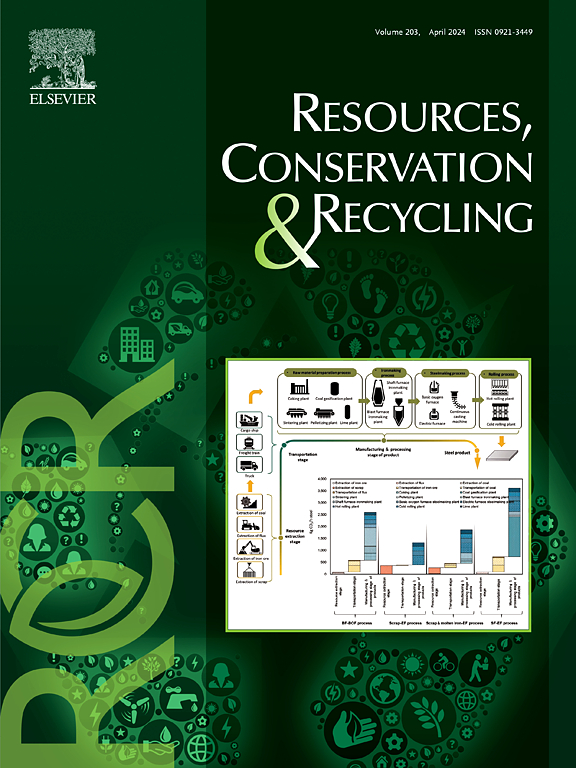Tracing the carbon footprint of cotton garments from seed to garment: Evidence from an empirical study of multiple sites in China
IF 10.9
1区 环境科学与生态学
Q1 ENGINEERING, ENVIRONMENTAL
引用次数: 0
Abstract
Greenhouse gas (GHG) emissions from Chinese textile production are an important component of global industry, but their intensity varies by textile type. This study addresses the issue of scant research on the carbon footprint of cotton garments in China. Using cross-provincial surveys, emission coefficients, and life cycle assessment (LCA) methods, we analysed the environmental impact of five major types of cotton garments, providing insights into their environmental effects. The carbon footprints significantly differed among the five garments used in this study: childrenswear (2.42 kg CO2eq), knitwear (7.24 kg CO2eq), fatigues (38.64 kg CO2eq), T-shirts (9.18 kg CO2eq), and workwear (20.25 kg CO2eq). At the production stage of cotton, the main components of carbon emissions are electricity, nitrous oxide (N2O) and fertilizers, accounting for 49.18, 18.84 and 14.10 % of emissions, respectively. The impacts of textile production depend on the energy cost, processing technique, and factory size. Additionally, we analysed four optimization scenarios—utilizing clean energy, optimizing factory sizes, using organic cotton, and enhancing recycling, which could reduce carbon footprints by 52.48, 30.43, 35.95 and 62.40 %, respectively. This finding suggests a potential approach for mitigating carbon emissions from cotton textile production and supporting the transformation of the cotton textile industry towards sustainable development, providing a basis for global emission reduction strategies in the cotton textile industry.

追踪棉质服装从种子到服装的碳足迹:来自中国多个地点的实证研究证据
中国纺织生产的温室气体排放是全球工业的重要组成部分,但其排放强度因纺织品类型而异。本研究解决了中国棉质服装碳足迹研究不足的问题。通过跨省调查、排放系数和生命周期评估(LCA)方法,我们分析了五种主要棉质服装的环境影响,为其环境影响提供了见解。本研究中使用的五种服装的碳足迹差异显著:童装(2.42千克二氧化碳当量)、针织品(7.24千克二氧化碳当量)、工作服(38.64千克二氧化碳当量)、t恤(9.18千克二氧化碳当量)和工作服(20.25千克二氧化碳当量)。在棉花生产阶段,碳排放的主要成分是电力、一氧化二氮(N2O)和肥料,分别占排放量的49.18%、18.84%和14.10%。纺织品生产的影响取决于能源成本、加工技术和工厂规模。利用清洁能源、优化工厂规模、使用有机棉和加强回收利用4种优化方案可分别减少52.48%、30.43%、35.95%和62.40%的碳足迹。这一发现为减少棉纺织生产碳排放和支持棉纺织工业向可持续发展转型提供了潜在的途径,为棉纺织工业的全球减排战略提供了基础。
本文章由计算机程序翻译,如有差异,请以英文原文为准。
求助全文
约1分钟内获得全文
求助全文
来源期刊

Resources Conservation and Recycling
环境科学-工程:环境
CiteScore
22.90
自引率
6.10%
发文量
625
审稿时长
23 days
期刊介绍:
The journal Resources, Conservation & Recycling welcomes contributions from research, which consider sustainable management and conservation of resources. The journal prioritizes understanding the transformation processes crucial for transitioning toward more sustainable production and consumption systems. It highlights technological, economic, institutional, and policy aspects related to specific resource management practices such as conservation, recycling, and resource substitution, as well as broader strategies like improving resource productivity and restructuring production and consumption patterns.
Contributions may address regional, national, or international scales and can range from individual resources or technologies to entire sectors or systems. Authors are encouraged to explore scientific and methodological issues alongside practical, environmental, and economic implications. However, manuscripts focusing solely on laboratory experiments without discussing their broader implications will not be considered for publication in the journal.
 求助内容:
求助内容: 应助结果提醒方式:
应助结果提醒方式:


